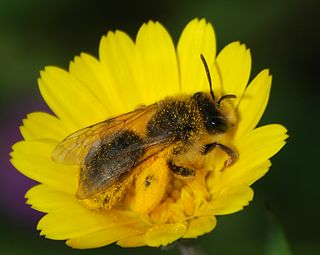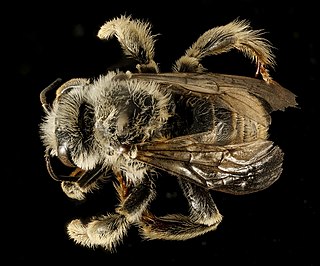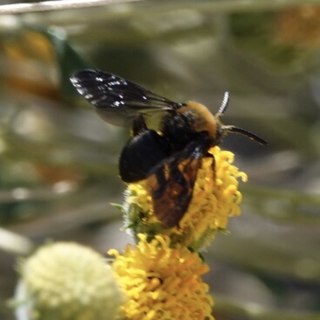
Mason bee is a name now commonly used for species of bees in the genus Osmia, of the family Megachilidae. Mason bees are named for their habit of using mud or other "masonry" products in constructing their nests, which are made in naturally occurring gaps such as between cracks in stones or other small dark cavities. When available, some species preferentially use hollow stems or holes in wood made by wood-boring insects.

Juglans californica, the California black walnut, also called the California walnut, or the Southern California black walnut, is a large shrub or small tree of the walnut family, Juglandaceae, endemic to Southern California.

Andrena is a genus of bees in the family Andrenidae. With over 1,500 species, it is one of the largest genera of animals. It is a strongly monophyletic group that is difficult to split into more manageable divisions; currently, Andrena is organized into 104 subgenera. It is nearly worldwide in distribution, with the notable exceptions of Oceania and South America. Bees in this genus are commonly known as mining bees due to their ground-nesting lifestyle.

The California carpenter bee, Xylocopa californica, is a species of carpenter bee in the order Hymenoptera. It is native to western North America.

Ashmeadiella is a genus of bees in the family Megachilidae. There are more than 60 described species in Ashmeadiella.
Brachymelecta interrupta is a species of digger-cuckoo bee in the family Apidae, found in Central America and North America.

Brachymelecta is a genus of digger-cuckoo bees in the family Apidae, formerly known by the name Xeromelecta.

Hoplitis is a genus of bees in the family Megachilidae. There are more than 380 described species in Hoplitis.

Neolarra is a genus of cuckoo bees in the family Apidae. There are about 16 described species in Neolarra, all from North America.

Diadasia australis is a species of chimney bee in the family Apidae. It is found in Central America and North America.
Dufourea echinocacti, the barrel cactus dufourea, is a species of sweat bee in the family Halictidae. It is found in North America, mainly in California and northwestern Mexico. The name Echinocacti comes from its affinity for the Echinocactus genus of barrel cactus, which are found throughout the Dufourea Echinicacti's habitat. It was first described by Philip Hunter Timberlake in 1939.

Anthophora californica is a species of anthophorine bee in the family Apidae. It is found in Central America and North America.

Perdita californica is a species of bee in the family Andrenidae. It is found in Central America and North America.

Brachymelecta larreae is a species of cuckoo bee in the family Apidae. It is found in Central America and North America.
Evaniella californica is a species of ensign wasp in the family Evaniidae. It is found in North America.
Neolarra californica is a species of cuckoo bee in the family Apidae. It is found in Central America and North America.

Bombus californicus, the California bumble bee, is a species of bumble bee in the family Apidae. Bombus californicus is in the subgenus Thoracobombus. It is found in Central America and the western half of North America. Bombus californicus is classified as Vulnerable by the IUCN.

Paranomada is a genus of cuckoo bees in the family Apidae. There are at least three described species in Paranomada.

Augochloropsis is a genus of brilliant metallic, often blue-green, sweat bees in the family Halictidae. There are at least 140 described species in Augochloropsis.

Xylocopa tabaniformis, the horsefly-like carpenter bee or mountain carpenter bee is a species of carpenter bee in the family Apidae. It is found in Central America, North America, and South America. It is 12–18 millimetres long and black. Males have yellow hair on the thorax.















